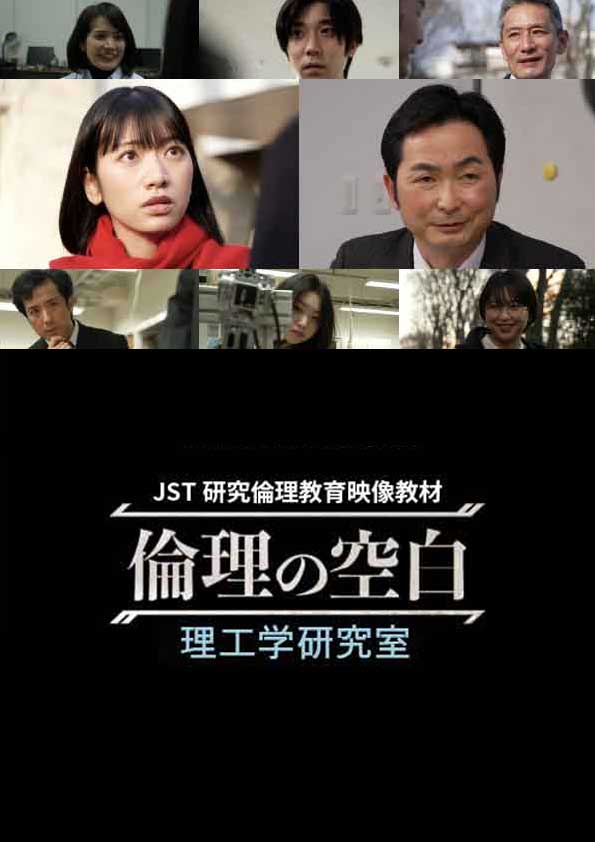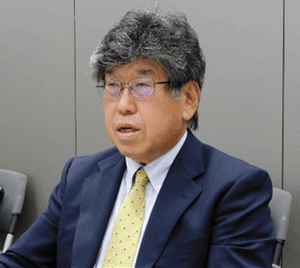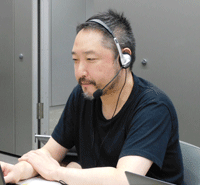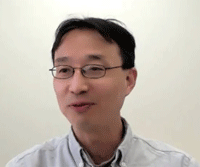Event Reports
The 9th JST Workshop "Promoting Activities toward Research Integrity - Learning effective ways to use the Research Ethics Instructional Video, Gaps in Ethics"(5 Oct '22 ,12 Oct '22)

The 9th JST Workshop " Promoting Activities toward Research Integrity- Learning effective ways to use the Research Ethics Instructional Video" was held online on 5 October and 12 October. In this workshop, participants learned how to use the instructional video "Gaps in Ethics", which allows them to simulate an actual research misconduct.* The purpose of this workshop is to provide participants with an understanding of educational perspectives and various ways of thinking when using instructional videos, so that they can contribute to promoting activities ethics education and research integrity at their own institutions. What the workshop was like that day is shown below.
Lecture
"Thinking about How to Use Research Ethics Instructional Videos" by Professor Jun Fudano, Waseda University

The workshop started with a lecture by Professor Fudano. Professor Fudano talked about the social background of the rapid increase in the discovered research misconduct, and explained that in recent years, in addition to fabrication, falsification, and plagiarism, problems such as double posting, self-plagiarism, and authorship have also been rapidly increasing as research misconduct. It was also shown that Japanese research institutes have provided education from the aspect of preventive ethics, but they are also aiming to create an environment in the future where better research can be conducted by placing importance on aspirational ethics.
He also mentioned that the U.S. National Institutes of Health (NIH) revised its guidance on responsible conduct of research (RCR) education in February 2022. The revision explains that RCR education is expected to be conducted not only online but also using face-to-face or alternative discussion-based education methods, and that it is important that the frequency of RCR education is at least once per career stage and once every four years to continuously raise awareness of research ethics.Next, it was explained that new deficits have been added as a result of the revised guidance. New items include the definition of harassment in the broader sense, the addition of d. "Safe research environment," and h. "Safe and ethical data use and data confidentiality" from the viewpoint of research integrity. In addition, RCR education is progressing at each research institution even in Japan in accordance with the guidelines of the Ministry of Education, Culture, Sports, Science and Technology. Professor Fudano introduced one of such cases, which was the systematization of RCR education that has been implemented at Tokyo Institute of Technology according to the steps of ethics education. To promote RCR education, it is necessary to educate on ethical judgment, problem-solving, and the emotional domain. Specifically, methods such as active learning are required instead of conventional passive learning.
Model lecture
In the model lecture, participants were divided into groups of four to six people, and then divided into two groups, and they experienced the lecture shown below. When the groups were formed, they were composed of members whose specialized fields were close, and it was possible to discuss issues specific to the individual fields.Model lecture 1: Professor Shunzo Majima, Tokyo Institute of Technology, "Using the Student and Young Researcher Edition"

Professor Shunzo Majima Professor Majima's model lecture was based on a problem-solving ethical decision-making method chart (steps 1-5). It's a method of taking steps to avoid bad decisions and ultimately makimg rational decisions. the importance of research integrity that is not considered "boring" but something that protects researchers, was brought up again in his introduction. Additionally, he expressed his hope that each individual will take something away from the lecture as it relates to themselves
Outline of the model lecture[Time] 90 minutes in total
[Targets] Research ethics faculty development activities for graduate students or research ethics training sessions
[Purpose] To recognize and understand research ethics as participants' own, and to encourage thought and action on the proactive prevention of research misconduct on their own initiative.
[Goals]
1. In the instructional video "Gaps in Ethics - The Science and Engineering Research Center" Student Edition, the participants can identify the location of the ethical problem that is faced by the leading character, Sasayama.
2. The participants can analyze and solve the ethical problem that Sasayama faces using the problem-solving ethical decision-making method chart.
Problem-solving ethical decision-making method chart
Step 1: Identify the problem
Step 2: Identify stakeholders and persons who have potential impact
Step 3: List as many possible actions as you can think of
Step 4: Implement a reality check on the actions listed in step 3
Step 5: List the realistic actions left in step 4 in a time series
First, Professor Majima explained the chart-based decision-making method using a familiar virtual case, "tasty salt-flavored cabbage". In the beginning, the participants wrote down initial and secondary actions that they thought they would do on a piece of paper, and then laid the paper face down. Next, they followed the steps in the chart to make decisions, and at the end, they reviewed the details that they had written in the beginning and compared them to the actual conclusions. Although there may not be a big difference, Professor Majima said that it is important to recognize the process of making logical decisions visually.
Next, after viewing about half of "Gaps in Ethics" Student and Young Researcher Edition, the participants discussed in groups what they could do as the leading character, Sasayama, by counterfactual thinking.
Then, they compared and examined the results of the group discussions to the first second best actions they had written.
It was an important process to "visualize" what ethical decisions were made when "common sense" results were derived. The important point of this work was to think step-by-step about what would be the best or second-best ethical actions.
At the end of the lecture, the participants shared their impressions of the model lecture among the groups, and enumerated, discussed, and summarized arguing points for questions and improvement points, followed by a Q&A session on the model lecture.
They would like to use this model lecture to conduct classes, but they wonder if it is acceptable to conduct classes with students and faculty members, and if it is acceptable to jointly gather faculty members from various departments.
I think it is good to allow people from various fields to participate in classes. In the sense of knowing the other person, it is also good to show professors the Student and Young Researcher Edition, and to show the students the Associate Professor Edition. I think it will be an opportunity to get to know each other.
Model lecture 2: Yasunori Yamanouchi, Associate Professor, Tohoku University, "Using Associate Professor Edition"

Overview of the model lecture (50 minutes including 5-minute introduction)
[Time] A 45-minute research ethics training session
[Targets] Faculty members (without video previewing)
[Method] Real-time distribution
[Purpose] To reacknowledge that faculty members are not in a position to receive research ethics education, but in a position to provide research ethics education
In the "exchange of opinions" part, groups discussed situations in the instructional video which could lead to research misconduct. Then, the participants considered how they could give advice and guidance to Associate Prof. Segawa if the paticipants were Prof. Onuma.
Next, in the "actual response" part, the participants discussed episodes similar to the situation shown in the video, and enumerated and shared preventive measures to address the gap between "ideal and reality." In some cases, the participants exchanged opinions on differences in perceptions between researchers from several decades ago and current researchers, and the differences in research methods in each research field.
Associate Prof. Yamanouchi said that he would like the participants to use case-based instructional videos to link knowledge and practice and conduct research ethics education in research practice. In addition, he said that research ethics education is embedded in words and actions during research activities, and that it is important to "use words during research activities" at the research site, and ultimately, "I want you to create an environment that makes it easier for researchers to conduct good research."
Finally, there was a Q&A session even in this model lecture.
It was good that the content of the lecture for faculty members was considered to be less burdensome.
It is difficult to ask faculty members to view the video or related material beforehand, so it is considered better to have them view it in class as much as possible. I would like to conduct research ethics education with the image of creating a good system, placing the intention of "wanting to protect research activities" in the forefront.
The "Gaps in Ethics" is interesting and good content, but I think there are few descriptions related to Professor Onuma's research.
Why was Professor Onuma's work adopted for this lecture? In fact, it would be good to raise the point that there is not much description regarding that in the instructional video, which is one of the problems.
Next, based on the prework, specific educational goals and plans of educational activities (methods of utilization and application) using the instructional video "Gaps in Ethics" for students or faculty members were examined.
In each group, various opinions were exchanged, and lively discussions were held. Finally, a presentation was given on the results by the participants and comments on them were provided from the lecturer.
The following are examples of educational activity plans created during the workshop group work and comments from the lecturers.
◆ (For students) Educational activity plan (methods of utilization and application):
-
In addition to identifying problems by viewing the video, participants share information on "what actions should have been really done" and "the talks of their own similar experiences" with groups of the participants and deepen their thoughts on the following points.
- Examples of fabrication and falsification of data
- Causes and countermeasures for research misconduct
- The meaning and importance of authorship
- After the discussion, some explanations (answers) are given, and the participants give their opinions on what they have learned from the training session and what actions they should take in the future.
- The presentation group said, "We prepared a lecture plan with some answers in mind, being aware that it is for students."
- Professor Fudano commented, "It is very well thought out, but it may be difficult to summarize the details in 90 minutes, so it seems good to divide them into three times. The relationship between mentors and mentees, i.e., advisors and students are an important part of research ethics, and it is important for both parties to learn."
◆ (For faculty members) Educational goals (goals to be achieved through educational activities):
- Setting "What is research misconduct?" as a theme and including self-plagiarism and questionable research practices (QRPs), etc., lets students gain experience that "deeply resonates" with them, in combination with viewing the instructional video.
- Discussing a "bright future" when making the right decisions, and conditions under the "What would you do?" assumption through thinking one half each from the standpoint of faculty members and that of students, it was proposed that participants should be mindful of using research ethics for the purpose of improving the level of research.
- Professor Fudano commented, "It is important to incorporate not only preventative ethics, but also what is good to do as a researcher in a 'bright future' as aspirational ethics."

Overall comments
In the workshop, Professor Yamanouchi commented, "It was a valuable opportunity where people from companies and universities were able to think about ethics education together. In the future, if you can exchange opinions with each other, you will be able to take interesting approaches. Research ethics education may be effective when combined with improvement of skills such as laboratory management. In addition, I think it would be good if people in the field could create and maintain an organization and environment that encourage research integrity on their own." Professor Majima commented, "All of your ideas for educational activities are attractive and I would like to see their effects. Quality control of research data leads to self-protection and also protects the other party. That way, I think we can build a sound organization."Professor Fudano stated, "I believe that research ethics lies at the foundation of thinking about how to conduct research better. I hope that you will adopt not only preventive ethics but also aspirational ethics. You all have strong aspirations, so I hope that you will share your wisdom so that you can conduct better research at your institution or laboratory." The workshop concluded with the comments above.
After the workshop, the participants gave opinions and pointed out issues in the questionnaire which they answered as follows.
"First of all, listening to the model lecture gave me a more concrete picture."
"Through the group work, I learned again that it is important to incorporate diverse perspectives."
"It was designed to be flexible and allow the participants to think and work together."
"I was able to hear model cases and evolutionary ideas from the theoretical viewpoint of research ethics and structure."
"I'm worried that I don't have the experience to implement the content of the lecture (after receiving the model lecture."
"(The problem is), there is no facilitator."
"The issue is to create the content so that participants feel that it was meaningful."
"It's difficult to set conditions within a limited amount of time."
Report on the 6th Workshop

